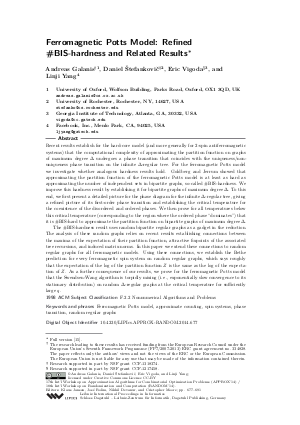Ferromagnetic Potts Model: Refined #BIS-hardness and Related Results
Authors Andreas Galanis, Daniel Stefankovic, Eric Vigoda, Linji Yang
-
Part of:
Volume:
Approximation, Randomization, and Combinatorial Optimization. Algorithms and Techniques (APPROX/RANDOM 2014)
Part of: Series: Leibniz International Proceedings in Informatics (LIPIcs)
Part of: Conference: International Conference on Randomization and Computation (RANDOM)
Part of: Conference: International Conference on Approximation Algorithms for Combinatorial Optimization Problems (APPROX) - License:
 Creative Commons Attribution 3.0 Unported license
Creative Commons Attribution 3.0 Unported license
- Publication Date: 2014-09-04
File

PDF
LIPIcs.APPROX-RANDOM.2014.677.pdf
- Filesize: 0.52 MB
- 15 pages
Document Identifiers
Subject Classification
Keywords
- Ferromagnetic Potts model
- approximate counting
- spin systems
- phase transition
- random regular graphs
Metrics
- Access Statistics
-
Total Accesses (updated on a weekly basis)
0PDF Downloads0Metadata Views
Abstract
Recent results establish for the hard-core model (and more generally for 2-spin antiferromagnetic systems) that the computational complexity of approximating the partition function on graphs of maximum degree D undergoes a phase transition that coincides with the uniqueness/non-uniqueness phase transition on the infinite D-regular tree. For the ferromagnetic Potts model we investigate whether analogous hardness results hold. Goldberg and Jerrum showed that approximating the partition function of the ferromagnetic Potts model is at least as hard as approximating the number of independent sets in bipartite graphs, so-called #BIS-hardness. We improve this hardness result by establishing it for bipartite graphs of maximum degree D. To this end, we first present a detailed picture for the phase diagram for the infinite D-regular tree, giving a refined picture of its first-order phase transition and establishing the critical temperature for the coexistence of the disordered and ordered phases. We then prove for all temperatures below this critical temperature (corresponding to the region where the ordered phase "dominates") that it is #BIS-hard to approximate the partition function on bipartite graphs of maximum degree D. The #BIS-hardness result uses random bipartite regular graphs as a gadget in the reduction. The analysis of these random graphs relies on recent results establishing connections between the maxima of the expectation of their partition function, attractive fixpoints of the associated tree recursions, and induced matrix norms. In this paper we extend these connections to random regular graphs for all ferromagnetic models. Using these connections, we establish the Bethe prediction for every ferromagnetic spin system on random regular graphs, which says roughly that the expectation of the log of the partition function Z is the same as the log of the expectation of Z. As a further consequence of our results, we prove for the ferromagnetic Potts model that the Swendsen-Wang algorithm is torpidly mixing (i.e., exponentially slow convergence to its stationary distribution) on random D-regular graphs at the critical temperature for sufficiently large q.
Cite As Get BibTex
Andreas Galanis, Daniel Stefankovic, Eric Vigoda, and Linji Yang. Ferromagnetic Potts Model: Refined #BIS-hardness and Related Results. In Approximation, Randomization, and Combinatorial Optimization. Algorithms and Techniques (APPROX/RANDOM 2014). Leibniz International Proceedings in Informatics (LIPIcs), Volume 28, pp. 677-691, Schloss Dagstuhl – Leibniz-Zentrum für Informatik (2014)
https://doi.org/10.4230/LIPIcs.APPROX-RANDOM.2014.677
BibTex
@InProceedings{galanis_et_al:LIPIcs.APPROX-RANDOM.2014.677,
author = {Galanis, Andreas and Stefankovic, Daniel and Vigoda, Eric and Yang, Linji},
title = {{Ferromagnetic Potts Model: Refined #BIS-hardness and Related Results}},
booktitle = {Approximation, Randomization, and Combinatorial Optimization. Algorithms and Techniques (APPROX/RANDOM 2014)},
pages = {677--691},
series = {Leibniz International Proceedings in Informatics (LIPIcs)},
ISBN = {978-3-939897-74-3},
ISSN = {1868-8969},
year = {2014},
volume = {28},
editor = {Jansen, Klaus and Rolim, Jos\'{e} and Devanur, Nikhil R. and Moore, Cristopher},
publisher = {Schloss Dagstuhl -- Leibniz-Zentrum f{\"u}r Informatik},
address = {Dagstuhl, Germany},
URL = {https://drops.dagstuhl.de/entities/document/10.4230/LIPIcs.APPROX-RANDOM.2014.677},
URN = {urn:nbn:de:0030-drops-47319},
doi = {10.4230/LIPIcs.APPROX-RANDOM.2014.677},
annote = {Keywords: Ferromagnetic Potts model, approximate counting, spin systems, phase transition, random regular graphs}
}
